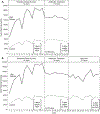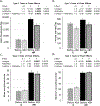Oral antibiotics reduce voluntary exercise behavior in athletic mice
- PMID: 35504410
- PMCID: PMC9725099
- DOI: 10.1016/j.beproc.2022.104650
Oral antibiotics reduce voluntary exercise behavior in athletic mice
Abstract
The gut microbiome can affect various aspects of both behavior and physiology, including exercise ability, but effects on voluntary exercise have rarely been studied. We studied females from a selection experiment in which 4 replicate High Runner (HR) lines of mice are bred for voluntary exercise and compared with 4 non-selected control (C) lines. HR and C mice differ in several traits that likely interact with the gut microbiome, including higher daily running distance, body temperatures when running, spontaneous physical activity when housed without wheels, and food consumption. After two weeks of wheel access to reach a stable plateau in daily running, mice were administered broad-spectrum antibiotics for 10 days. Antibiotic treatment caused a significant reduction in daily wheel-running distance in the HR mice (-21%) but not in the C mice. Antibiotics did not affect body mass or food consumption in either HR or C mice, and we did not observe sickness behavior. Wheel running by HR mice did not recover during the 12 days following cessation of antibiotics. The decreased wheel-running in HR but not C mice, with no apparent negative side effects of antibiotics, suggests that the HR microbiome is an important component of their high-running phenotype.
Keywords: Antibiotics; Behavior; Exercise; Gut microbiota; Host-microbe interaction; Wheel running.
Copyright © 2022 The Authors. Published by Elsevier B.V. All rights reserved.
Figures







Similar articles
-
Maternal exercise opportunity before, during, and after pregnancy alters maternal care behavior and offspring development and survival, but has few effects on offspring physical activity or body composition.Physiol Behav. 2025 Mar 15;291:114752. doi: 10.1016/j.physbeh.2024.114752. Epub 2024 Nov 15. Physiol Behav. 2025. PMID: 39549866
-
Effects of food restriction on voluntary wheel-running behavior and body mass in selectively bred High Runner lines of mice.Physiol Behav. 2024 Aug 1;282:114582. doi: 10.1016/j.physbeh.2024.114582. Epub 2024 May 14. Physiol Behav. 2024. PMID: 38750805
-
Effects of voluntary exercise on spontaneous physical activity and food consumption in mice: Results from an artificial selection experiment.Physiol Behav. 2015 Oct 1;149:86-94. doi: 10.1016/j.physbeh.2015.05.025. Epub 2015 May 27. Physiol Behav. 2015. PMID: 26025787
-
The use of a running wheel to measure activity in rodents: relationship to energy balance, general activity, and reward.Neurosci Biobehav Rev. 2012 Mar;36(3):1001-1014. doi: 10.1016/j.neubiorev.2011.12.012. Epub 2012 Jan 2. Neurosci Biobehav Rev. 2012. PMID: 22230703 Free PMC article. Review.
-
Hormones and the Evolution of Complex Traits: Insights from Artificial Selection on Behavior.Integr Comp Biol. 2016 Aug;56(2):207-24. doi: 10.1093/icb/icw040. Epub 2016 Jun 1. Integr Comp Biol. 2016. PMID: 27252193 Free PMC article. Review.
Cited by
-
Microbiota influence on behavior: Integrative analysis of serotonin metabolism and behavioral profile in germ-free mice.FASEB J. 2024 Jun 15;38(11):e23648. doi: 10.1096/fj.202400334R. FASEB J. 2024. PMID: 38822661 Free PMC article.
-
Host-specific effects of Eubacterium species on Rg3-mediated modulation of osteosarcopenia in a genetically diverse mouse population.Microbiome. 2024 Dec 2;12(1):251. doi: 10.1186/s40168-024-01971-1. Microbiome. 2024. PMID: 39623488 Free PMC article.
-
Limosilactobacillus Fermentun ZS09 Can Improve Antibiotic-Induced Motor Dysfunction in Mice by Regulating the Brain-Gut Functions.J Inflamm Res. 2024 Nov 30;17:10093-10106. doi: 10.2147/JIR.S486018. eCollection 2024. J Inflamm Res. 2024. PMID: 39634287 Free PMC article.
References
-
- Acosta W, Meek TH, Schutz H, Dlugosz EM, Vu KT and Garland T Jr.. (2015). Effects of early-onset voluntary exercise on adult physical activity and associated phenotypes in mice. Physiol. Behav. 149, 279–286. - PubMed
-
- Acosta W, Meek TH, Schutz H, Dlugosz EM and Garland T Jr. (2017). Preference for Western diet coadapts in High Runner mice and affects voluntary exercise and spontaneous physical activity in a genotype-dependent manner. Behav. Processes 135, 56–65. - PubMed
-
- Bercik P, Denou E, Collins J, Jackson W, Lu J, Jury J, Deng Y, Blennerhassett P, Macri J, McCoy KD, et al. (2011). The intestinal microbiota affect central levels of brain-derived neurotropic factor and behavior in mice. Gastroenterology 141, 599–609.e3. - PubMed
-
- Bindels LB and Delzenne NM (2013). Muscle wasting: The gut microbiota as a new therapeutic target? Int. J. Biochem. Cell Biol. 45, 2186–2190. - PubMed

